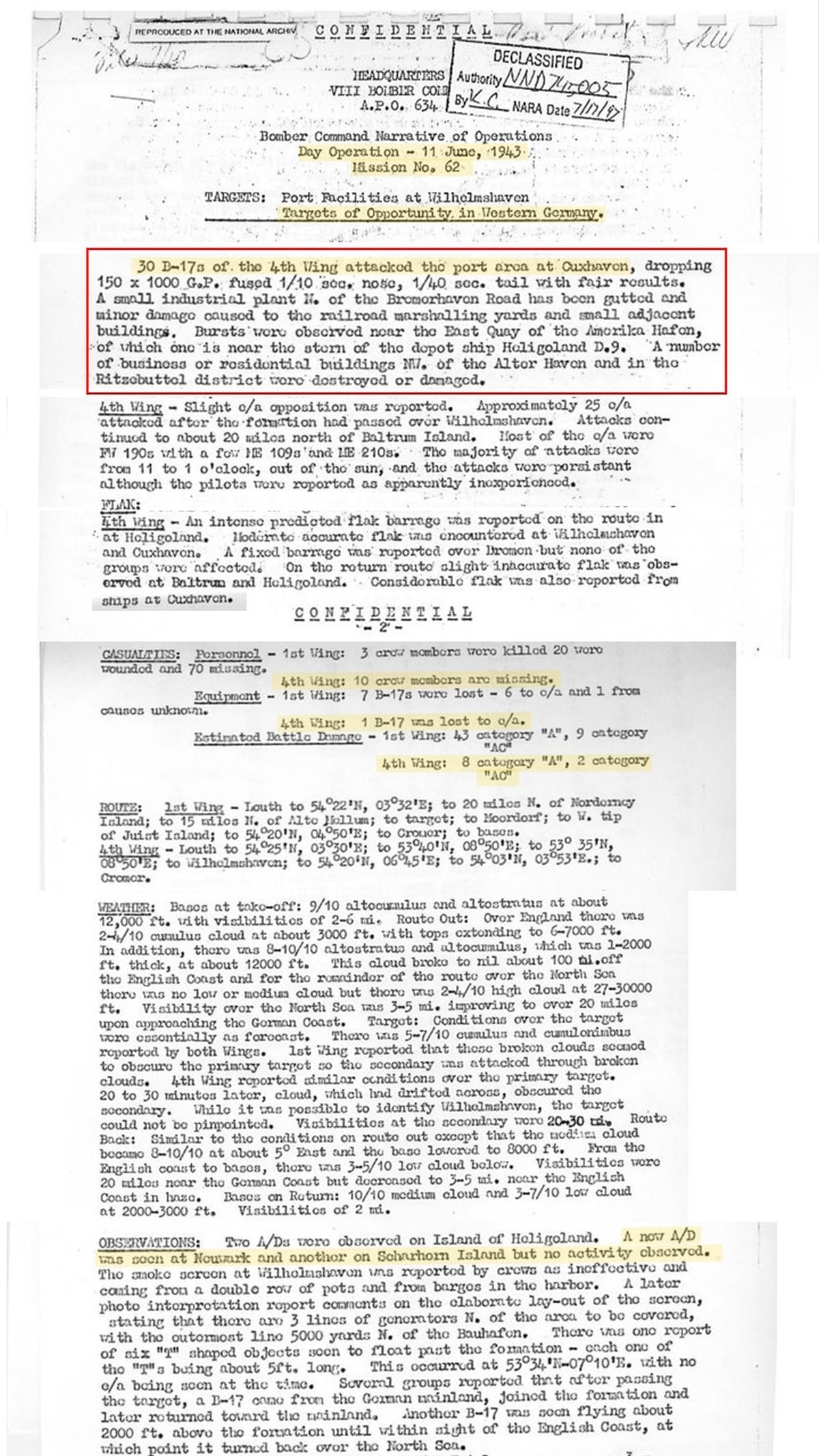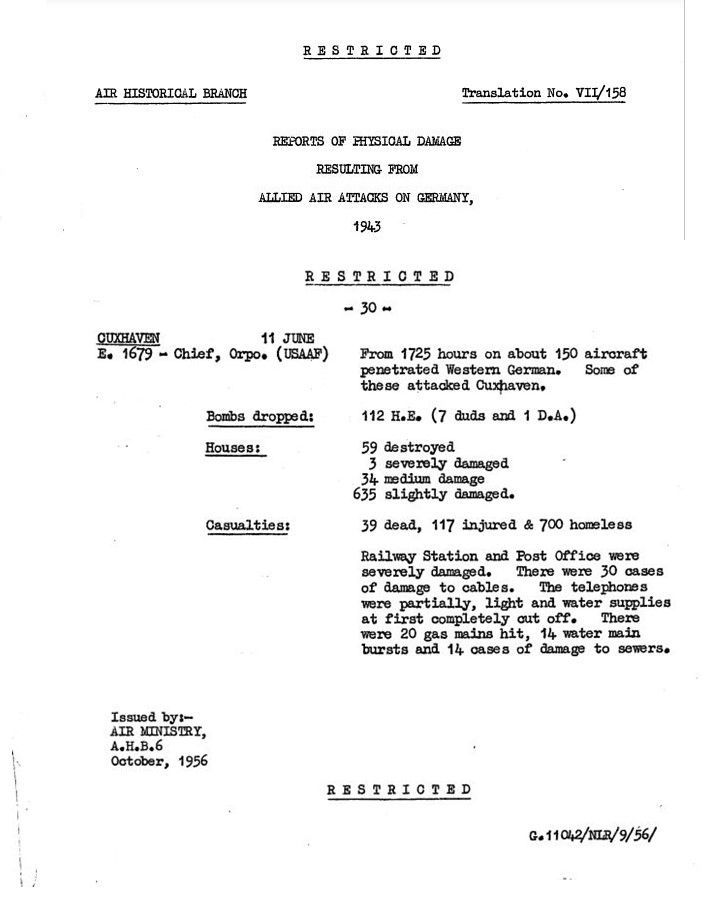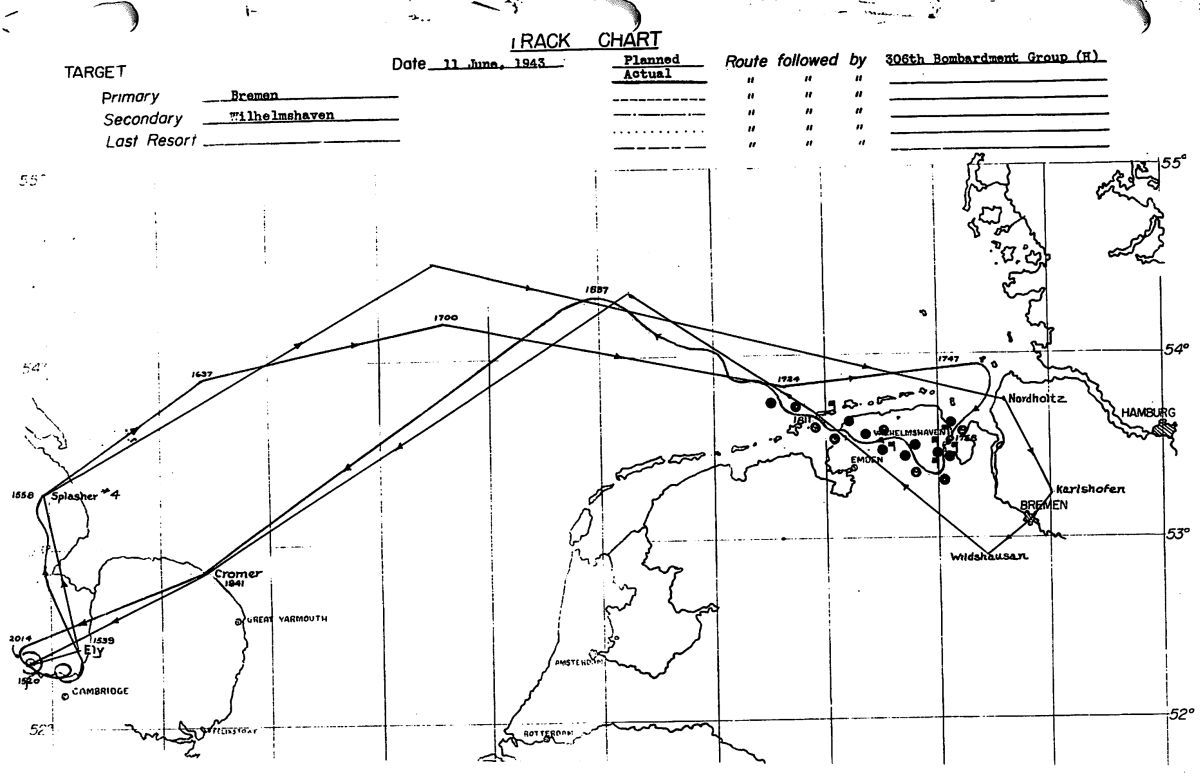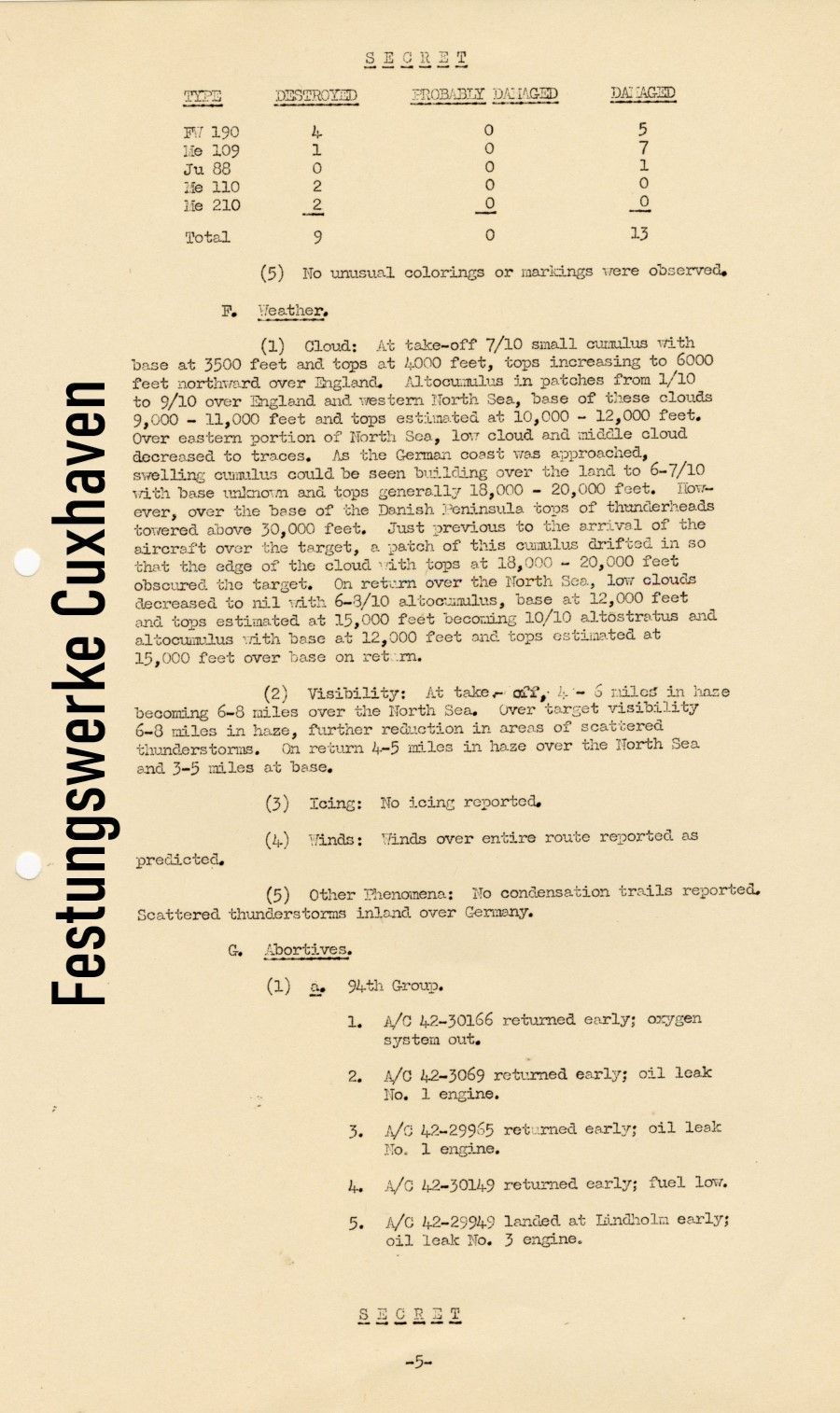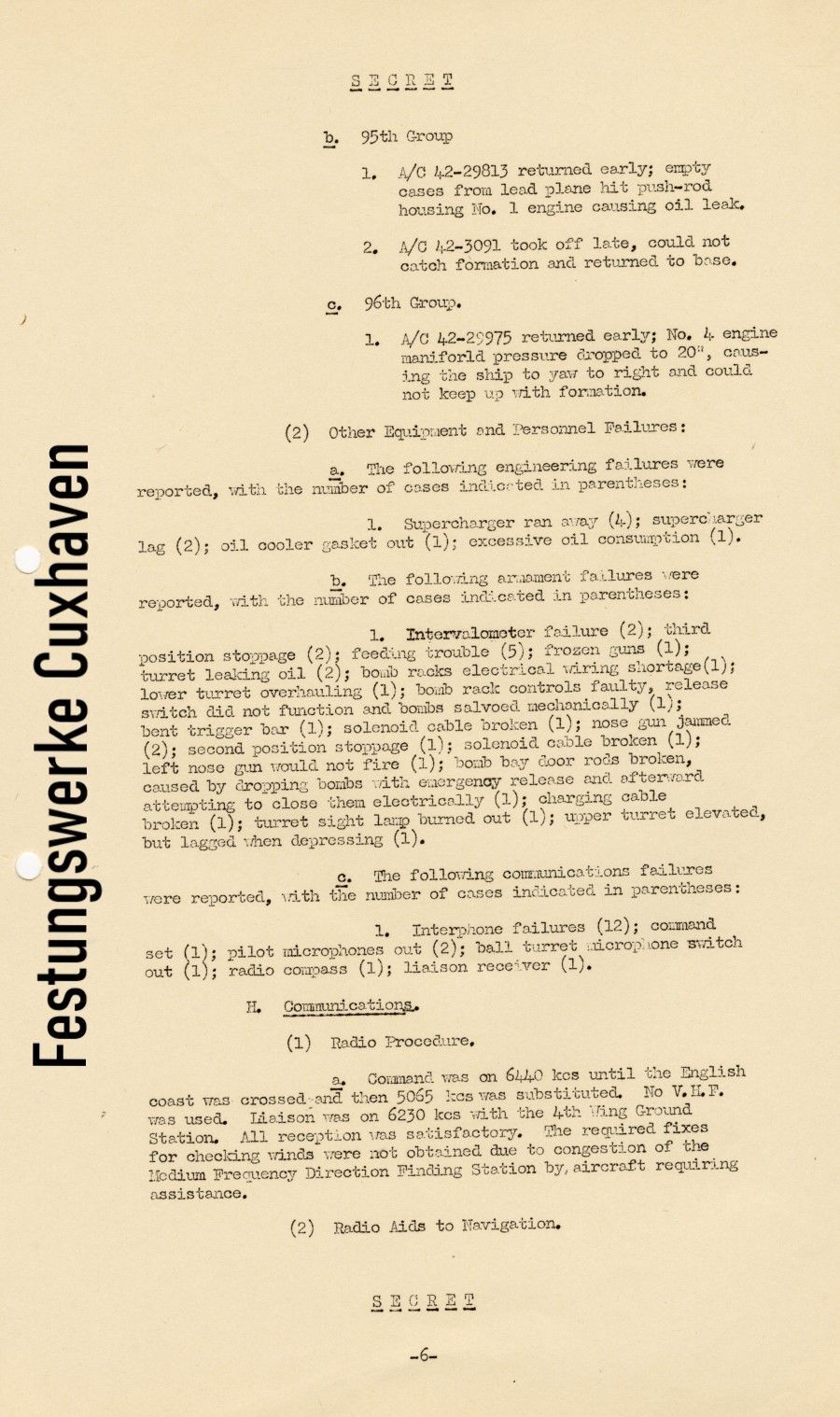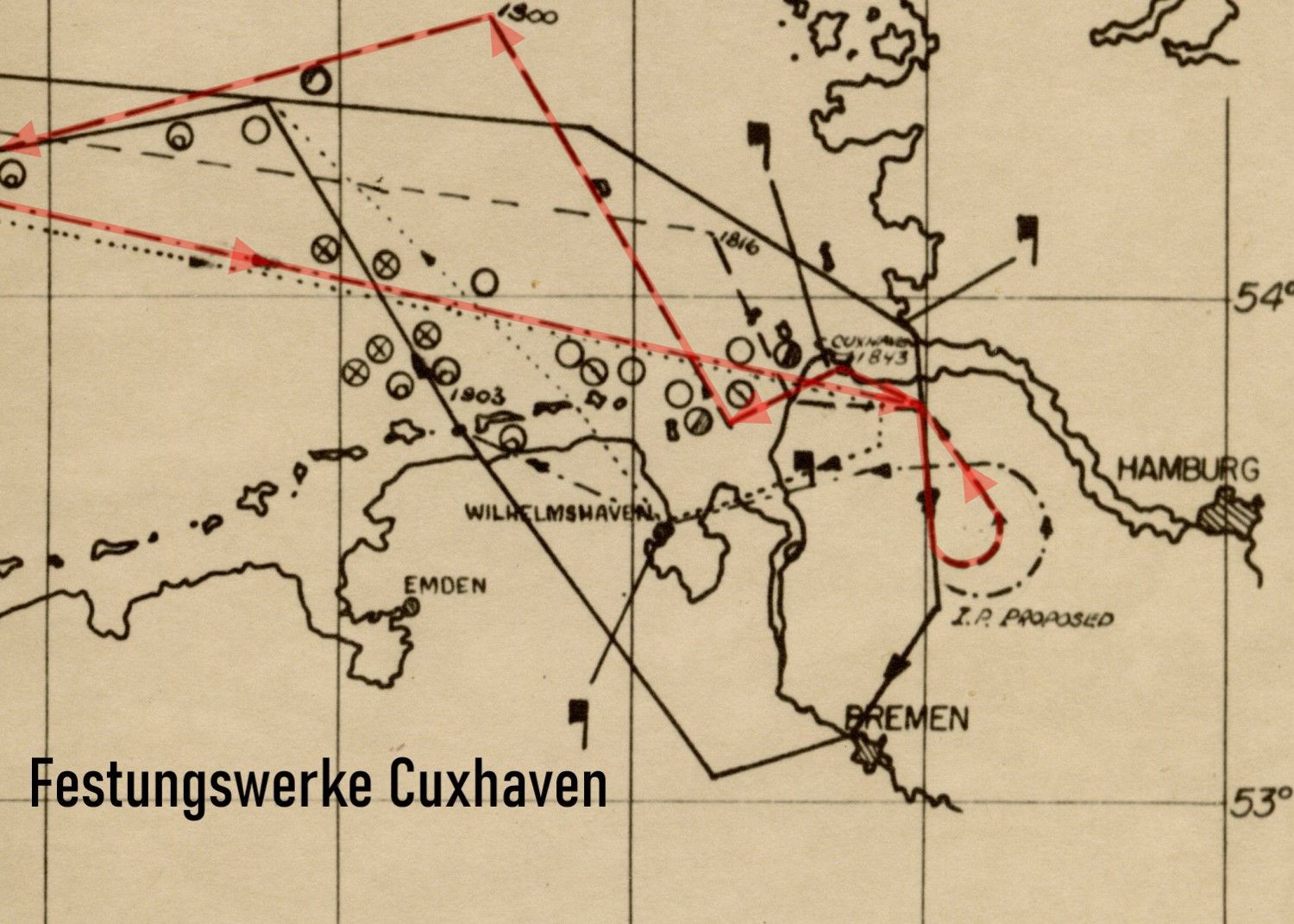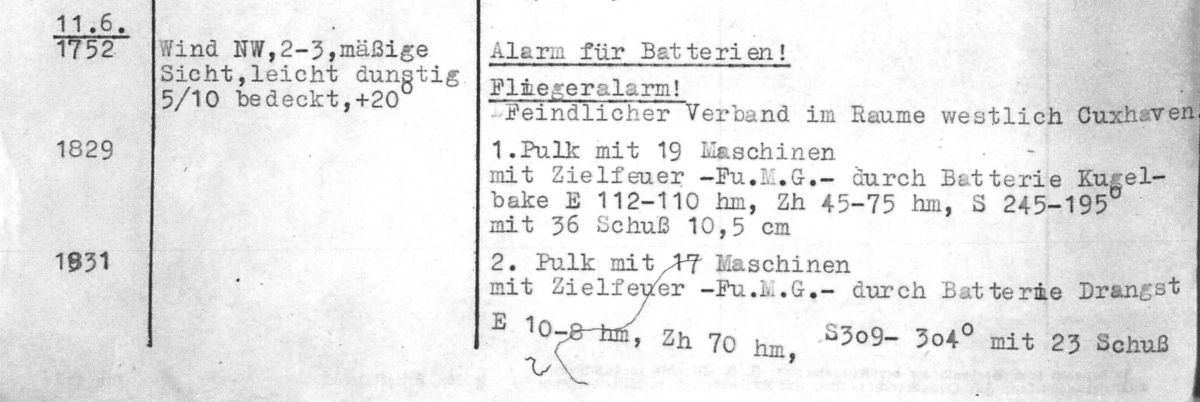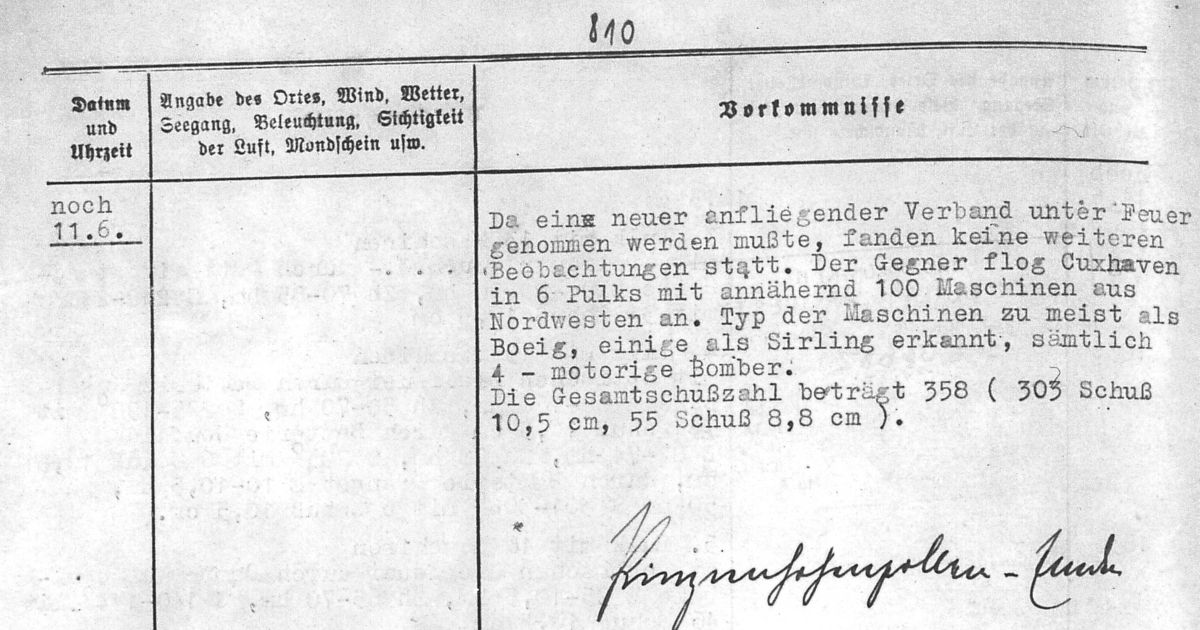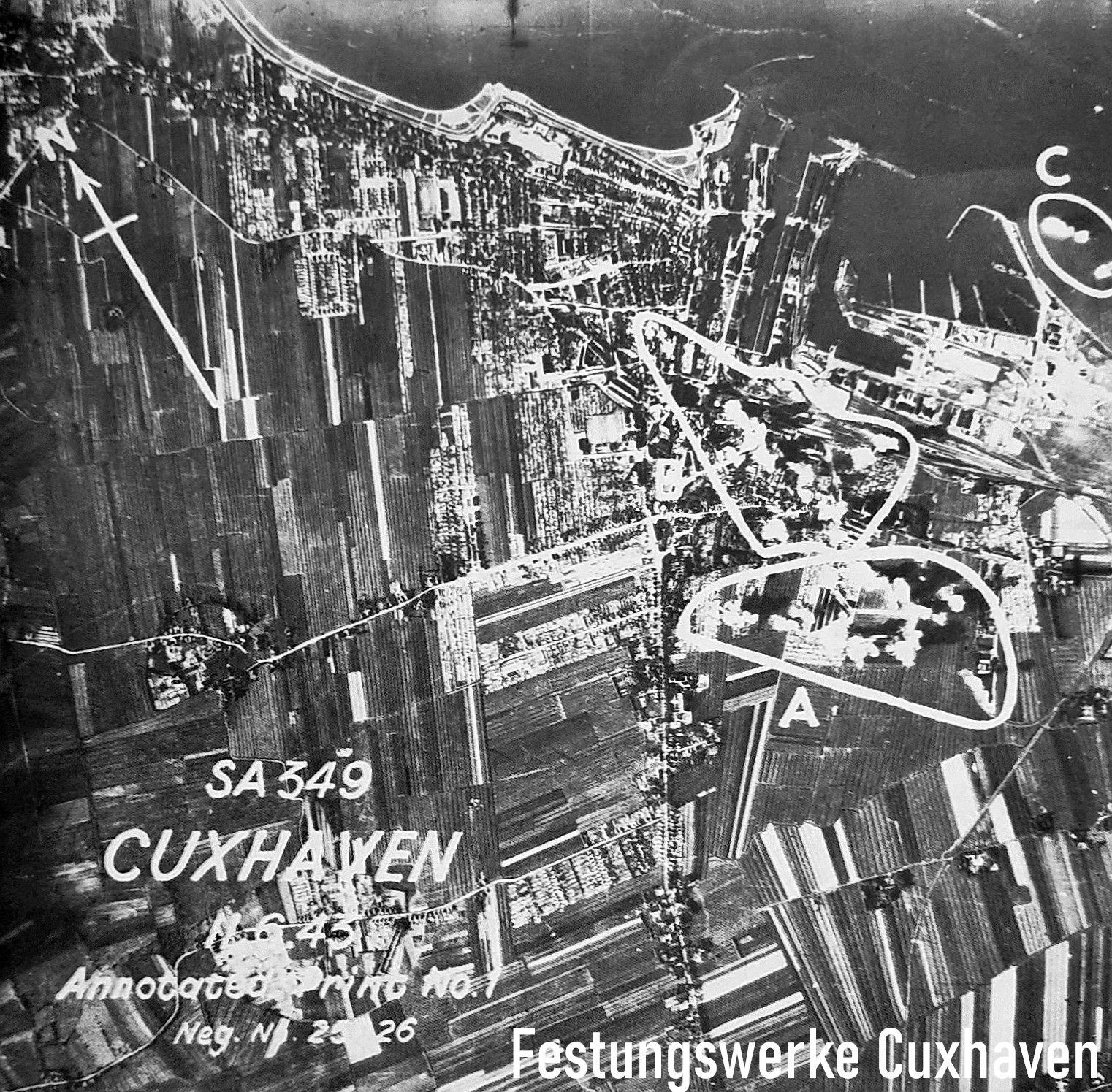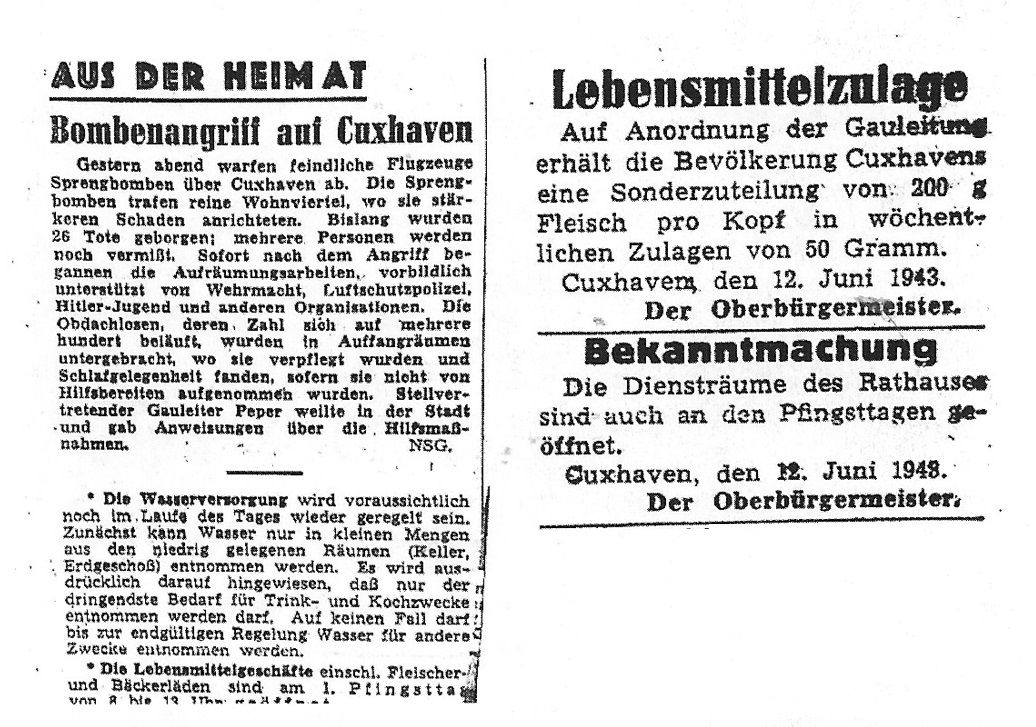
Am 11.06.1943 griffen amerikanische Luftstreitkräfte der 8th Air Force in einem großen Unternehmen die Städte Bremen, Wilhelmshaven, sowie weitere Gelegenheitsziele im Nordwesten Deutschlands an. Hauptziele dieser Mission waren die Hafen- und Industrieanlagen, Infrastruktur sowie U-Boot-Basen der zwei Städte.
To attack Wilhelmshaven and Bremen, Allied Bomber Command deployed the largest number of heavy bombers (252 aircraft) ever sent on a single mission. This was the first airborne mission since 29 May 1943, after heavy bomber forces were built up in Great Britain in early June. Since then, there have been 17 heavy and 3 medium bomb groups in the United Kingdom.
The first unit of this formation was a combined force of 166 B-17s (Flying Fortress) dispatched from the 1st Bomb Squadron: 91BG (21); 92BG (14); 303BG (25); 305BG (24); 306BG (27); 351BG (24); and 379BG (31), whose objective was to bomb the naval installations at Wilhelmshaven. This was a "maximum effort" operation.
A second formation of 97 Boeing B-17s (Flying Fortress) was dispatched from the 4th Bomb Squadron: 94Bomb-Group (29); 95BG (29) and 96BG (28) dedicated themselves to targets in Bremen.
During the final approach to Bremen, the lead aircraft of the 94th Bomb Group found a bad weather zone with cumolus clouds (thunderstorm activity) in the target area. The local weather no longer permitted a successful attack on the city at this time and only for this reason was Cuxhaven declared an alternative target of opportunity that day. To do this, the combat group made a 200° turn and headed northwest. In the meantime, the 96th BG had also joined the 94th Bomb Group with its B17 bombers. The joint 401st group now consisted of 30 Boeing B 17 bombers.
East of Cuxhaven, the leading bombardier of the 94th BG set his primary target for the bombing to be the area between the Amerikahafen and the train station. The leading bombardier of the 96th BG did not find a direct primary target for a short time and set his drop points roughly from the harbor across the city area. The 94th Group dropped its high-explosive bombs from 27,000 ft. (8230 m), the 401 from 25,500 ft. (7770 m), the bombs took about 30 seconds to reach their destination.
Die amerikanische Luftauswertung beschreibt im Nachhinein 38 Treffer in der direkten Innenstadt Cuxhavens, 8 Einschläge befanden sich im Bahnhofsumfeld, 4 Treffer gab es auf der Pier im Amerikahafen, 31 Einschläge gingen im Hafen ins Wasser und 17 Bomben fielen auf freies Feld. Das direkte Zielfeld war 1500 Meter x 330 Meter groß.
During the approach, the lead aircraft was badly hit by anti-aircraft fire from the Cuxhaven batteries and had to leave the formation; all other bombers successfully completed their approach. The damaged aircraft was later shot down by a fighter pilot over the North Sea.
Otherwise, the anti-aircraft fire during the attack on Cuxhaven was described as moderate and inaccurate. However, the unit came under heavy fire again near Heligoland. In the meantime, the bombers of the 401st were also attacked several times by around 25 - 50 German fighters. These were FW. 190, Me. 109, Ju. 88, Me. 110 and Me. 210. The fighters usually attacked in pairs from the sun and were, according to reports, very persistent. Later they flew to a safe distance and then suddenly launched a frontal attack. According to observations, 9 German fighters were shot down and 13 damaged.
The entire attack on the two port cities took place without their own fighter protection. On June 11, 1943, the RAF and the Americans intensified their air raids on German cities. The Allies' "Combined Bomber Offensive" began: During the day, the Americans launched precision bombings - at night, the RAF followed with area bombings. Source: Headquarters VIII Bomber Command, USAAF, APO 634, combat report
Excerpts from the report of the headquarters of the 8th USAAF Bomber Fleet on the attack on Cuxhaven on 11 June 1943
Der komplette Missions Report (62) vom Angriff am 11.06.1943 auf die Städte Wilhelmshaven, Cuxhaven und weiterer Gelegenheitsziele als PDF.
Excerpts from the present combat report of the IV. Wing of the 8th/US Bomber Command
Reports from the war diaries of the Commander of the Cuxhaven Section and Commander of the North Sea on this air raid.
The trail left by the 30 bombers was significant for Cuxhaven. The Americans' aerial photographs show numerous explosions south of the city center, in the city center in the harbor area and on the Elbe. 39 people, including children, were killed. During the air raid, 150 explosive bombs, each weighing 450 kilograms (1000 lbs.), were dropped on the city. The primary target of the attack, the harbor infrastructure, was only hit in places. Most of the impacts hit the water and the city center. The reason for this was probably the heavy anti-aircraft fire, which probably pushed the bomber group upwards. This in turn would have made it more difficult for the bombers to aim accurately from the great heights.
An aerial photograph taken by a reconnaissance aircraft after the operation. The impacts after evaluation.
The naval assistant WV of the Kugelbake anti-aircraft battery still remembers the devastating air raid of 11 June 1943:
Alarm! Once again enemy formations were reported approaching. It was clear summer weather and we were soon able to spot and measure the aircraft. It was a large formation of around 30 B 17 aircraft (American heavy long-range day bomber "Boeing B 17 Flying Fortress"). From Heligoland, which was usually a navigational point for these operations, it now flew into the mouth of the Elbe from the northwest. The English and Americans used the Elbe as a route for attacks on Berlin and Hamburg, dropping their bomb loads there day or night. As soon as the formation came within range of our guns, our battery, like all the others, opened fire from all barrels. Undeterred, the formation first moved past Cuxhaven in the direction of Brunsbüttel. One of the first planes (later it was assumed that it was the lead plane) was hit, turned south with a long plume of smoke and then crashed in the direction of Wurster Wattes. The entire formation then turned and flew directly towards Cuxhaven. Naval assistant H.Sch. adds: At the time I was at the 6m base as an E-measuresman and had to follow the formation closely. When the planes turned and headed for Cuxhaven, I watched as one after the other opened the bomb hatches and the bombs fell out. A whole carpet of bombs came down, from the middle of the southern fairway across the port area and into the city. Although our battery was firing and vibrating, we felt the shock of the bombs hitting us. They flew away just as they had come, leaving a huge cloud over the city. There were no German fighters to be seen, and these "flying fortresses" flew without their own fighter escort. Our battery fired at the formation as long as it was still within range of our guns. When we returned to the barracks after the operation, everyone wanted to know what was going on. In all the questions, you could hear concern for parents and relatives, friends and relatives. Marine helper GM, who had returned from vacation, reported on the damage he had seen and the losses. We only learned of the full extent of the destruction the next day and the day after that.
The Boeing B17 hit by the anti-aircraft guns during the attack was most likely the aircraft with the registration 42-29693 "Lonesome Polecat". After the bomber had to leave the formation due to the hit, the aircraft flew westwards with a long plume of smoke, according to the statement of the naval aide Harald Schönemann. However, contrary to H.Sch.'s opinion, it did not crash into the mudflats near Dorum, but flew further towards the sea, badly damaged. Here it was finally discovered by the German fighter pilot Olt. "Heinz Knocke" from 5./JG 11 in his Messerschmidt Me 109 G from Jever. After a short aerial battle, the B 17 exploded and crashed into the North Sea near Heligoland, killing all 10 crew members.
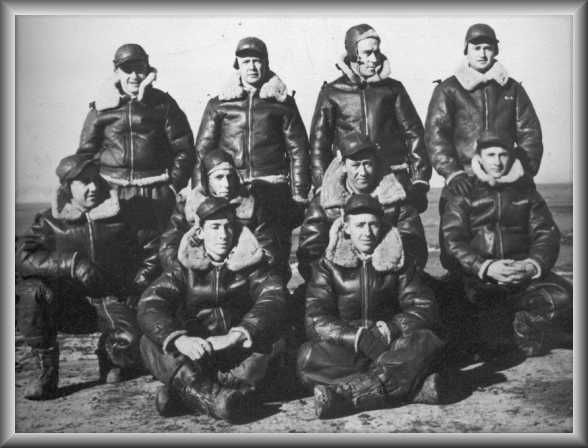
Crew 32 of the Boeing B-17 B-17F-65-BO "Lonesome Polecat", registration: 42-29693
95 Bomb Group / 412 Bomb Squadron - Rapid City Airfield, USA 02/1943
(Standing left to right) 1st Lt. Mackinnon, F/O Wood, 2nd Lt. Powell, 2nd Lt. Jenkins(Kneeling left to right) Sergeant Mareck, Sergeant Vail, Sergeant Davoren, Sergeant Babick(Front) S/Sgt Bennett, S/Sgt BlackridgeSeven of them were on the B-17 when it was shot down.
Missing crew (11 June 1943)
Pilot: Malcolm MacKinnon, Co-pilot: Gene Wood, Navigator: Dick Miller, Bombardier: Windell Neeley, Flight engineer/top turret gunner: George Babich, Radio Operator: John Vail, Ball turret gunner: Dick Cavanaugh, Waist gunner: John Davoren, Waist gunner: Alex Marek,Tail gunner: Stan Bennett
Those: http://franckruffino.chez.com/My-Site/Victory_10.htm, https://www.americanoirmuseum.com/archive/aircraft/42-29693
Kill report from Olt. Heinz Knoke - 5./JG 11 from Jever Air Base


Those: http://franckruffino.chez.com/My-Site/Victory_10.htm
The following can be read about this bombing raid in the Cuxhaven city archives: In addition to severe damage to the post office building, the press building, the Niemeyer House on the corner of Deichstrasse, on Kämmererplatz, in Delftstrasse and Nordersteinstrasse (von Broock, corner of Nordersteinstrasse and Holstenstrasse, Drogerie Lues), the "Stahlhof" (Poststrasse), Hermannstrasse, and in Lehfeld, 39 people were killed in this attack.
Rescue and cleanup work began immediately after the attack. Although the press building had suffered considerable damage, newspapers could still be printed at the usual lunchtime. Postal services were also uninterrupted, although the destroyed counter hall could only be put back into operation after a new building was constructed on July 29, 1960.
The "Cuxhavener Tageblatt" reported on the severe damage in the city, but also on the great readiness to help by the population, the various organizations, the authorities and the military under the headline: "Cuxhaven on probation": The buried people were taken out of the air raid shelters, the wounded were cared for by lay helpers and transported to the German Red Cross stations.
Those who had suffered total bomb damage were taken in by the neighborhood, and the air raid police and the Wehrmacht immediately sent out relief teams. According to contemporary witnesses, the situation unfolded as follows: "... and when the all-clear was given, everyone, whether organized or unorganized, pitched in as best they could. Until dark, you could see men from the Navy and the Reich Labor Service, from the air raid police and the fire brigade, dusty and sweaty, working with shovels everywhere. Trucks from all companies rolled away the rubble, but ordinary men, who had no official duties, worked just as hard and determinedly, whether they were cleaning up their own house, the house next door or the company."
Die Spur der Bomben
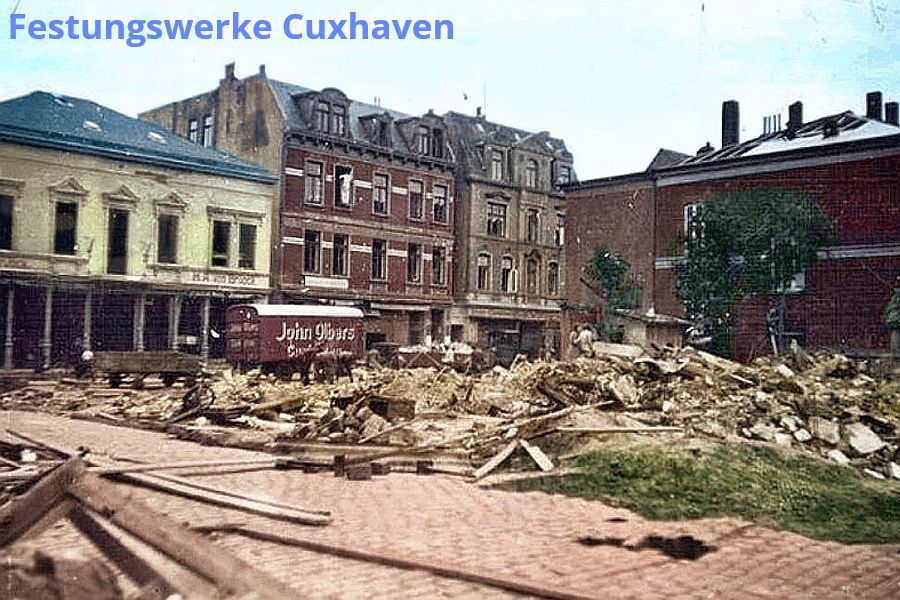
The destroyed "Drogerie Lüss", corner of Holstenstraße - Nordersteinstraße.
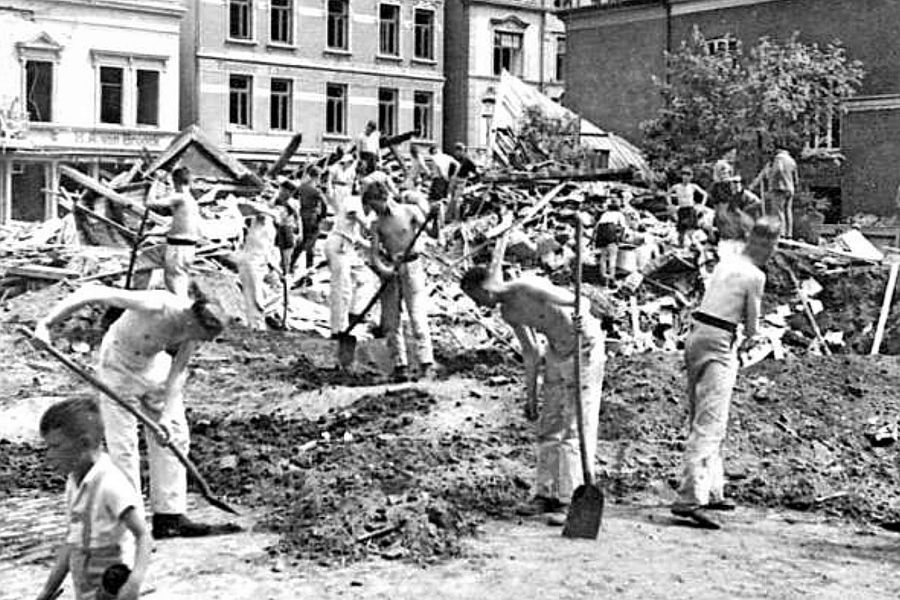
Clean-up work by men of the Reich Labor Service.

Treffer im Lehfeld / Photo Private.
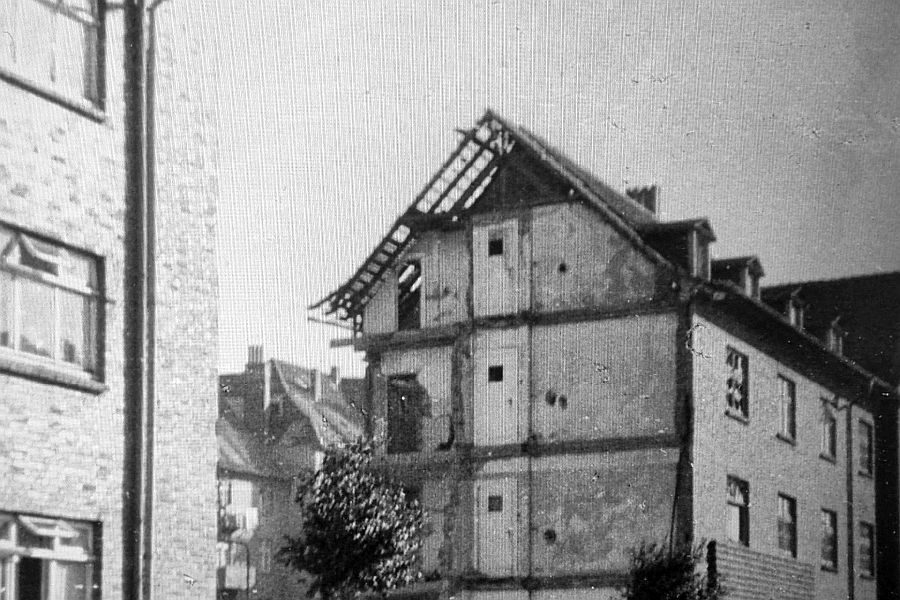
Volltreffer in der Delftstraße.
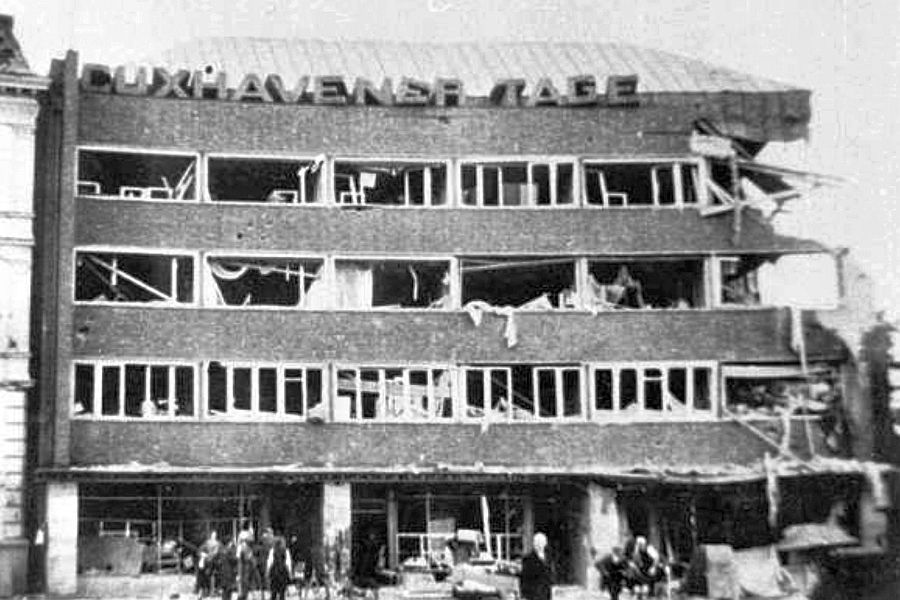


A direct hit in the building of the former Cuxhavener Tageblatt at today's Buttplatz.
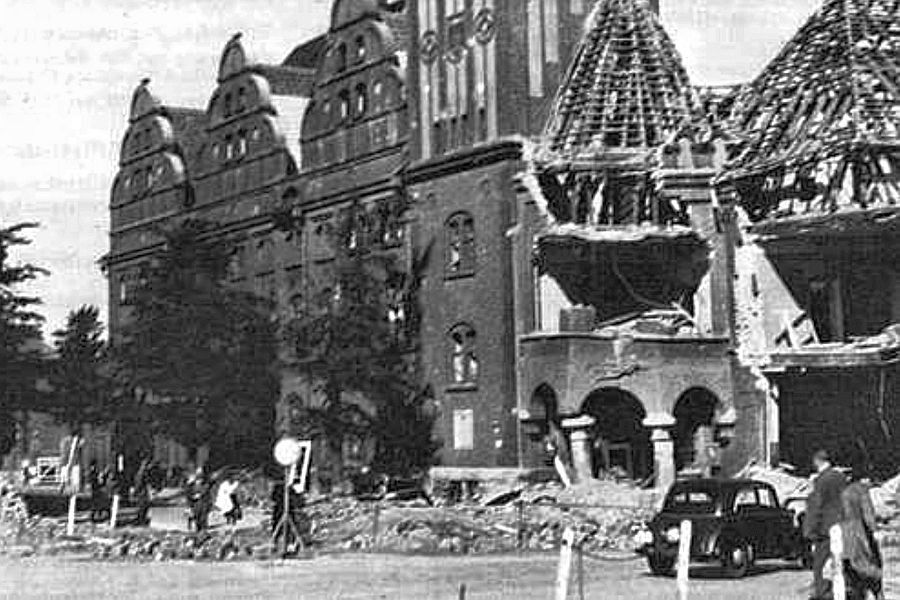

Direct hit in the main post office - Rhodestrasse.
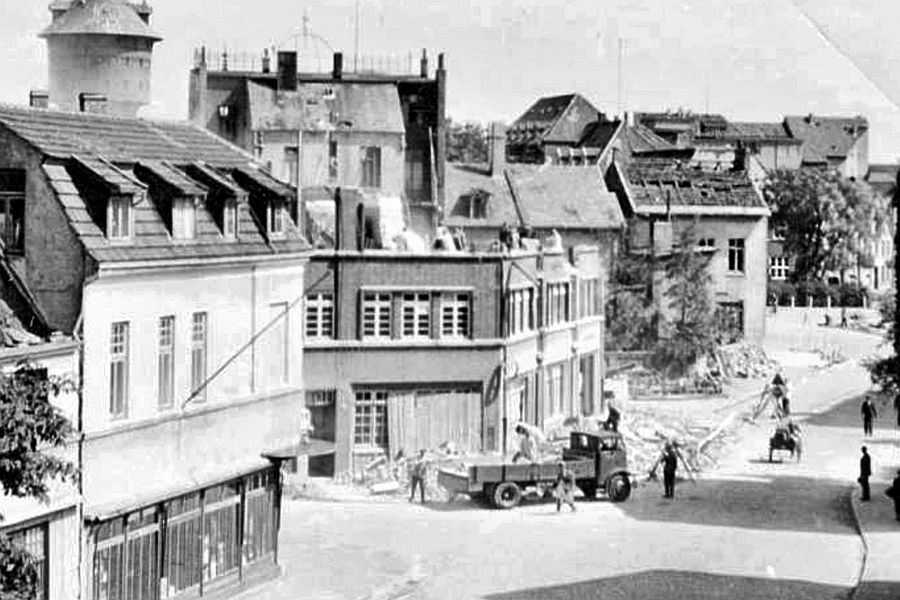
The former "Stahlhof" in what was then Franz-Seldte-Straße (today Poststraße), behind it the destroyed "Niemeyer House".
Quelle Fotos: Stadtarchiv, Privat, MB, Claus Seedorf
The mass of homeless people, those who had been completely destroyed by bombs, and those whose homes were threatened by unexploded bombs, went to the reception centers that had been set up in various schools. The women looked after these reception centers with exemplary zeal and almost touching care. The dishes and food that had been kept ready in large warehouses demonstrated how useful the precautions had been. The food was plentiful and excellent, and in the next few days the Wehrmacht kitchens cooked the meals. The following day the quarters offices also went into action, assigning quarters to the homeless based on large lists. Vehicles with loudspeakers drove through the streets and announced orders to the population. Our craftsmen met in five glazing centers - not just the glaziers, but also tailors, shoemakers, mechanics, electricians, etc. - to repair the windows that had been brought in. The carpenters repaired the broken frames and, above all, put the food stores in order. This time there was no Pentecost for Cuxhaven. Work was carried out with iron determination, and it is amazing how quickly the piles of rubble disappeared from the streets and everything slowly returned to its old tracks, as far as possible.Source: Marinehelfer in the Kugelbake battery, MB,



